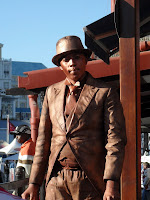Upon strolling through Cape Town’s CBD, the statue and monument situated on Church Square came forth as striking, as I have not seen this before. On the corner of Spin and Parliament Street, both the statue and monument is found on the door-step of Iziko’s Social History Centre and across street from the Groote Kerk’s back.
The tall bronze tarnished statue of Jan Hendrik Hofmeyer can be found in the Church Square. The statue is a tribute to his efforts to have Dutch claimed equal to the English language in the constitution of 1910. Jan Hofmeyer died in London on the 16th of October and his body was brought back to Cape Town where he was buried. The statue of Jan Hendrik Hofmeyer faces the mother church of the Dutch reformed church.
 Not too far from where you would find the statue of Jan Hendrik Hofmeyer, a young performing artist stood by the side-walk as a statue. He is known as Cape Town’s ‘living statue’ and is covered in bronze coloured body paint and stands there in the same spot for hours at various locations throughout Cape Town to earn money.
Not too far from where you would find the statue of Jan Hendrik Hofmeyer, a young performing artist stood by the side-walk as a statue. He is known as Cape Town’s ‘living statue’ and is covered in bronze coloured body paint and stands there in the same spot for hours at various locations throughout Cape Town to earn money. Church Square is said to house history dating back to 1652, around the time of the slave period in South Africa which was only in 1838 brought to an end. Cruise/Younge’s (Designers of the Slavery Memorial) commemorated the tragedy of slavery in the form of eleven granite blocks of different heights. The blocks (each being 80 centimetres square) represent a theme of our common humanity and the different heights represent growth.
With words from the slave period in South Africa, nine plain granite blocks are engraved with words that embrace the suffering on slave ships, rebellion, punishment, resistance, slave life and religion. The words run up one side of the blocks (which range between 80 centimetres to 40 centimetres high), over the top of it, and then down the other side of the blocks.
Engraved on the sides of the two 80 centimetres high blocks on the raised plinth, are the forgotten names of the enslaved. In remembrance of our fore-fathers, the aim is to remember the slaves for what they contributed to the building of the South African nation and for what they suffered for.
No comments:
Post a Comment